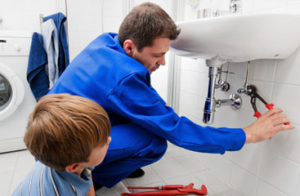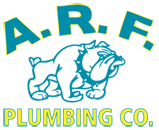Find where leaks are commonly found and how to tell if you have a leak that needs fixing.
In a single year a plumbing leaks can waste 2,000-20,000 gallons of water. The EPA estimates that the average household’s leaks can waste upwards of 10,000 gallons a year. Because of all this water, they can cause serious structural damage and mold problems. The kicker is that many leaks are not visible and hard to detect. A high water bill or visible stains could tip you off to a problem. Some leaks are easy to fix, while as others are hard to get at. Checking for, and locating  leaks will bring down your water usage, and can save you money.
leaks will bring down your water usage, and can save you money.
Below are some tips to help you check for leaks in your home, visible or not.
Indoor Plumbing Leaks
Start by looking at your fixtures and appliances.
Toilets are the most common leak offender, and can be hard to spot without testing, like;
- Condensation
- Water leaking from inside the toilet tank
- Leaking from between the tank and the bowl
- Fill valve shank gasket leak
- Leak from the fill valve refill tube
- Cracks in the tank
- shut-off valves that leak
- Leaking supply line
- Water from underneath the toilet
Also in the bathroom, check out your tub, shower, sink areas, as well as the floors around them. Any stains, curled flooring, or loose tiles should alert you to an existing problem.
If you have shower doors, try standing inside with the doors shit, and splash water around the door and frame. If you find any water outside, you’ll need to replace any worn floor sweeps and gaskets on the door, and possibly re-caulk the frame. Though seemingly minor, these kinds of leaks can seep water into the subfloor, potentially rotting the wood and developing into a major (and costly) repair.
The tub/shower drain can separate slightly from the floor, allowing water to leak outside the drain body and into flooring.
Plastic or fiberglass tubs and shower pans find themselves at risk for this kind of leak, as those materials will flex an bow. A simple check for this kind of leak is to simply fill the tub or shower with enough water to create a puddle, insert the plug, and wait a few minutes. If the puddle in the tub shrinks, it may be time to re-caulk, replace a gasket, or install a whole new drain.
Faucets are can also be a common source of leaks. These leaks are usually obvious, and easy to fix. A leaking faucet often only needs a replacement part or new o-ring to be fixed.
Leaky sinks problems with water around the rim, which can damage countertops and cabinets. Stains or small puddles around the sink and inside the cabinet can alert you to a problem. If you do discover any leaks, they can usually be taken care of with a re-caulking, or tightening of the sink’s undermount clips (if applicable).
Water heaters are an other item that don’t have hidden leaks. When you see water on the ground around your heater, check the temperature and pressure relief valve: if it’s constantly leaking, you need to check the temperature and pressure. If these are within the operating limits of the heater, you’ll need to replace the valve. If the valve doesn’t appear to be the culprit, check the fittings and stops connected to the heater, and replace as necessary. Sometimes condensation from the heater will create wet spots or puddles. While this isn’t technically a “leak”, condensation can cause problems. Check that all heater venting is clear. You may end up needing to adjust settings on the unit, or even consult with a plumber to resolve the issue.
Outdoor Leaks
Outdoor leaks can also be hard to detect, and a leak in a swimming pool can be especially hard to notice. A simple way to find out if your pool is wasting water is “the bucket test”. Set a bucket down on a step in the pool, and fill it to match the pool’s water line. Mark the water levels on both the inside and outside of the bucket, and come back about 24 hours later to see if the pool’s water level has gone down any.
If you have a sprinkler system or irrigation for a garden, turn the water on and keep an eye on all the lines for damaged heads or leaks. Some systems may leak when the water is off, usually due to a malfunctioning valve. A sprinkler system may betray leaks in its piping through especially green or lush areas.
Hidden Leaks
Some leaks know how to hide. If you’ve tried everything mentioned above and found nothing, but still have your suspicions that there’s a leak somewhere, there is one more thing to try before calling the plumber. While you may not be able to locate them, you can at least confirm the existence of a larger leak (or several smaller ones) using your water meter. If you don’t know where your supply shut-offs or water meter are located.
Make sure that every faucet and water-using appliance in and around your home is off. Keep in mind any automatically-controlled devices like ice makers, pool fillers, and pumps, and be sure to disable them. Once you’re certain your house shouldn’t be drawing any water, take a look at the water meter. Any water or dampness in the meter housing could be sign of a leak: if a source cannot be found on the meter, it could point to a leak on the supply line (water from a leak can travel down the length of a pipe to collect in a completely different area from the leak).
Check for movement of the flow indicator (a smaller dial on the meter face, usually with a large triangle in the center). If it’s moving, water is flowing somewhere. If it’s still, you’re not safe yet: the leak may be slight. For a more thorough test, record the number displayed on the meter register (the main display recording your home’s water use), and come back a minimum of 15 minutes later to see if any water has been used. For more reliable results, you can leave everything off overnight, then check for usage. Remember, though: the bathroom is off-limits during this period!
Should you end up detecting a leak, you can get a better idea of its general location by shutting off the main water supply outside your home. If meter-movement still occurs, you have a leak in the piping going between the meter and the house. No movement? Your leak is somewhere in the house. If your water meter test comes up negative, this does not necessarily mean you’re in the clear. Some leaks are only occasionally active, and it could be that your test was performed outside of that window. If you still think you may have a leak, it’s time to call your plumber.
